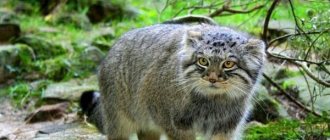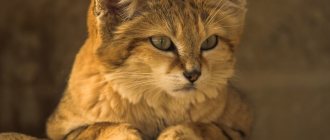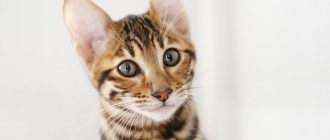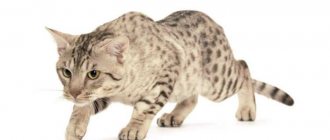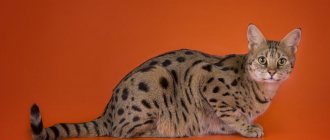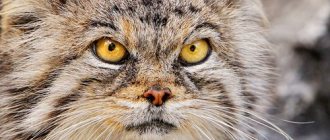Manul is a representative of the wild cat world, which, according to global network ratings, is one of the most popular exotic animals. Unusual long hair, small ears pressed to the head, and the intelligent look of amazing eyes made this cat a real Internet star.
Do not forget that this is not a breed of cute pet, it is a wild predator that is unlikely to ever be able to get along with a person.
Description and origin of the species
The first scientific description of the animal was given by the German naturalist Peter Simon Pallas in 1776. He met the animal while traveling in eastern Siberia, and gave the cat its first scientific name Felis manul.
In 1842, Johann-Friedrich von Brandt, a German naturalist working in Russia, proposed placing the animal in a separate genus of Pallas' cat (
Otocolobus
).
Later in 1907, the British zoologist Reginald Innes Poukok finally approved the classification: the animal is the only representative of the monotypic genus of Pallas's cats, and bears the scientific name Otocolobus manul.
The name manul is borrowed from the Kyrgyz language, and translated means “cat” in Kyrgyz. In Mongolian the word sounds a little different, “manol”. The name Pallas' cat was first proposed by the English zoologist William Blanford. Latin genus name Otocolobus
comes from ancient Greek, and literally means dwarf ear.
The closest relative of the animal is the genus Eastern cats (Prionailurus). It includes small predators of the cat family that live exclusively in Asia - the Bengal cat, the Sumatran cat, the fishing cat and the spotted cat. According to mitochondrial DNA analysis, the ancestors of Pallas's cat separated from a common ancestor with eastern cats from 9.4 to 1.46 million years ago.
What does a manul look like - size and appearance
Pallas's cat is comparable in size to domestic cats. The body length of the animal is from 46 to 65 cm, the tail length is from 21 to 31 cm. The weight of the cat is on average from 2.5 to 4.5 kg. The animal has a stocky build, short legs and thick long fur, so in appearance the cat seems denser and more massive than it actually is. Pallas's cat has the thickest fur of all cats - there are up to 9,000 hairs per square centimeter, each up to 9 cm long.
The color of the animal varies from light gray to dark yellow, with vertical dark stripes on the body and front legs. In winter, the fur is grayer, and with less pronounced stripes, than in summer. at the ends the hair is painted white, which gives the skin a snow-dusted appearance. Dark rings are clearly visible on the tail, and dark spots on the forehead. On the cheeks, horizontal dark stripes extend from the corners of the eyes to the side. Dark and white circles around the eyes emphasize their round shape. There is light fur on the chin and throat, which smoothly blends into light gray on the belly.
Pallas' cat's paws are proportionally the shortest among all cats. The ears are very small, and low set and fairly wide apart. The muzzle is noticeably shorter than that of other cats, so it seems that the animal is looking from under its brows. Due to its short jaw, the cat has fewer teeth than other wild cats, but has long fangs. The animal has short claws, and unusual round pupils, compared to other felines.
Appearance
This steppe cat (the photo in our article will convince you of this) is very similar to a lynx. If not for its smaller size and uniform color, it could easily be confused with a dangerous predator.
The caracal has a graceful body, 82 cm long, a tail of 30 cm. Height is 45 cm. Weight can reach 19 kg. The high-set triangular ears are topped with fluffy tufts that can be up to 5 cm long.
The coat is very thick and short. The color may be reddish-brown on the back, the belly is white, and there are black markings on the sides.
Character and lifestyle
Manul, like other wild cats, leads a solitary and sedentary lifestyle. Each animal has its own territory, which they mark with scent marks. The size of its own range varies depending on the habitat and food supply, but no more than 10 square kilometers per predator.
During the day, animals rest in caves, rocky outcrops, former dens of marmots and foxes, and at dawn and in the late afternoon they go hunting. Cats hunt prey from ambush, or sneak up unnoticed, using stones and bushes for cover. The color of the animal perfectly camouflages it among the snow and stones.
Pallas cats are the most clumsy and slow of all wild cats. They are not adapted to running, and chase prey, relying solely on surprise attacks from ambush. In case of danger, they hide, camouflage themselves against the background of stones, and climb onto the rocks.
Nutrition
The wild cat is helped in hunting by its camouflage color, thanks to which it blends into the landscape. Its main diet is rodents, but it can also catch a gopher, a hare or a bird. In times of hunger, it does not disdain Orthoptera and other insects.
Prey, as a rule, lies in wait near burrows or under stones. The wild manul is not able to run fast; in case of danger, it hides from enemies in rocks and between stones.
Where does the manul live?
Pallas's cat lives in the steppes of Central Asia. It can be found in the following countries:
- Kazakhstan
- Tajikistan
- Kyrgyzstan
- Iran
- Afghanistan
- Pakistan
- Nepal
- India
- Butane
- Mongolia
- China
- Russia
In Russia, the Pallas's cat lives in the Trans-Baikal Territory, Chita, Altai, the Republic of Tyva and Buryatia. The animal is found in western China. Previously, Pallas's cat also lived in Armenia and Azerbaijan (in 2017 it was seen in the Zangezur National Park of Azerbaijan), but as of 2021, the populations in these countries have been almost completely exterminated.
As a habitat, the Pallas's cat prefers open steppe spaces with low snow cover in winter and a sharply continental climate. It is found in the highlands at an altitude of up to 4,000 meters above sea level - in rocky crevices, rocky outcrops, semi-desert areas of mountains and bush thickets. Practically does not live in forests and lowlands.
Varieties
Today, three subspecies of this steppe cat are known:
- Siberian or nominal. It lives in the northern part of its range. Has a gray color.
- Central Asian, who lives in Afghanistan, Turkmenistan, and Northern Iran. Distinguished by red fur.
- Tibetan - with darker fur, black stripes on the tail and body and brighter spots on the head. Lives in Northern India, Northern Pakistan, Tibet, Kyrgyzstan, Uzbekistan.
What does manul eat?
Pallas's cat feeds mainly on pikas, small birds (Asian mountain partridge), and mice (clawed gerbil, vole). The pika is a small animal belonging to the lagomorphs, the size of a hamster. Less commonly, Pallas's cat hunts tolai hares, gophers and young marmots. In the summer, when there are few pikas, the cat actively eats insects - grasshoppers, locusts, etc.
Reproduction and young
The mating season for Pallas cats is very short due to the harsh climate in its habitat. Estrus lasts only 26 to 42 hours, which is much shorter than that of other wild cats. Pregnancy lasts from 66 to 75 days, the female usually gives birth in April or May. In a litter, from 2 to 6 kittens are born. Kitten survival rate is quite low (44% of kittens die before 30 days of age), so large litters compensate for high mortality and harsh climate conditions.
Females give birth in a den lined with dry grass, feathers and wool. Crevices, small caves, and old holes of marmots, badgers, and foxes are used as dens. Kittens are born weighing only about 90 grams, blind and helpless, covered with thick fluffy fur, which is replaced by full adult fur at the age of 2 months. From 4 months, the cubs begin to hunt, at 6 months they reach the size of an adult cat and begin an independent life. Puberty in Pallas' cats occurs after 10 months.
Offspring
The mating season takes place in February-March. At this time, cats get into violent fights over cats. Offspring appear annually. A litter usually contains from two to six kittens. Cats do not take part in raising babies. But the mother cat takes care of her offspring very carefully - licks them, feeds them with milk, and warms them with her warmth. But if the cat is unhappy with the behavior of the kittens, she bites them. At three months the family goes hunting for the first time. Under natural conditions, the steppe cat lives from 10 to 12 years.
Natural enemies and threats
Pallas's cat is often hunted by wolves and eagle owls. In addition, at a young age the animal is very susceptible to infectious diseases. A serious threat to the animal is snowy winters and prolonged ice, as well as a reduction in food supply - a decrease in the population of rodents, pikas and other prey.
Human actions currently pose a significant threat to the species:
- poachers kill animals for their skins in Mongolia, China and Russia;
- wild cats regularly fall into snares set for marmots and hares, and traps for wolves and foxes;
- animals are often killed by herding and domestic dogs.
Attempts at domestication
No matter how much zoologists try to tame the Pallas's cat, he is extremely reluctant to live in zoos. Most individuals waste away before our eyes and contract all possible diseases. Their body is adapted to natural conditions, so life in the reserve brings torment to Pallas’s cat.
Some enthusiasts decide to keep such a cat at home. As a rule, the undertaking does not end very well. Pallas cats are not ready to cooperate with people and demonstrate this in every possible way.
The little manul in the house is an unpredictable hurricane , restrained only by the desire to get another portion of food. The cat does not get along with children and cannot be trained.
The owner who decides to make such a purchase will have sleepless nights. Pallas's cat stays awake in the dark, and his activity harms everything in the house. Furniture, sofas and curtains will be torn, and all horizontal surfaces will certainly be sprinkled with wool. This cat is very fluffy.
It is very difficult to find breeders who breed this breed. It is prohibited to catch these animals on Russian territory, and their numbers are constantly declining. Young animals often fall into traps and become victims of large predators. The status of the animal remains rare even in its native lands.
The wild cat Manul is an animal with an unusual appearance and amazing habits. Perhaps this is the only species that does not want to get acquainted with humans and become domesticated. But, despite the hermit lifestyle, Pallas' cat fans continue to love these wayward little savages.
Population and conservation of the species
It is difficult to calculate the exact number of animals due to the inaccessibility of their habitat and excellent camouflage, but the number of cats is declining everywhere. According to data at the beginning of the 2000s, there were from 3,000 to 3,650 Far Eastern individuals left in Russia, most of them were in the Chita region.
The wild cat is listed as a “species of least concern” by the IUCN Red List and is included in the Russian Red Book. Hunting for Pallas's cat is prohibited in all countries of its habitat except Mongolia.
Since 2013, the Far Eastern Pallas's cat has been studied in the Daursky National Nature Reserve as part of the Russian Geographical Society's program for the conservation of Pallas's cat in Transbaikalia. The main goals of the program are to study the animal's natural habitats and migrations, as well as measure the survival rates of kittens and adults.
As of 2010, there were 47 individuals kept in zoos around the world. Pallas' cat breeds well in captivity, but they are highly susceptible to disease due to an underdeveloped immune system. In the wild, animals' habitat is limited, and outside of it, animals suffer from viruses that are not found in their natural environment of the highlands and steppes.
Manulas at home
Many people, seeing the unusual appearance of the animal, want to keep it at home. Yes, in size and appearance it really resembles a domestic cat, but the Pallas's cat is a wild animal, and will remain so even if you adopt a kitten. It will not be possible to tame it even after keeping it at home for a long time.
Keeping a Pallas's cat at home, in addition to its wild nature, will be associated with other difficulties:
- animals do not eat unfamiliar food
- animals often get sick and are susceptible to viruses, since their immune systems are adapted only to their limited habitat
- The animal's long and thick fur will not allow it to be kept at home; it will be too hot.
Is it possible to keep him at home?
Unlike its relatives, the Pallas's cat cannot be domesticated due to its indomitable nature. It is believed that if any animal is taken home when it is still a small kitten, it can grow up tame, with behavior no different from a domestic cat. But this is not about the manula. There are no guarantees that it will take root. Even if he is raised by a domestic cat along with his kittens, the manul will not be able to love them, and when he grows up, he will be aloof both from his half-sisters and brothers, and from people whom he has known since childhood. You need to know about this in advance before the manul appears within the walls of the house in order to make a decision for yourself whether such a wayward pet will suit you.
